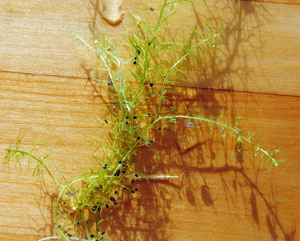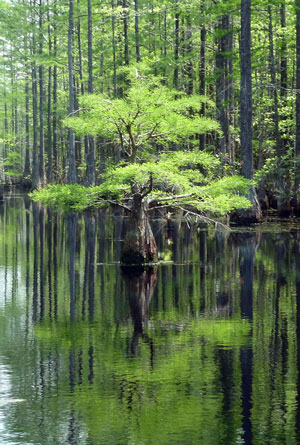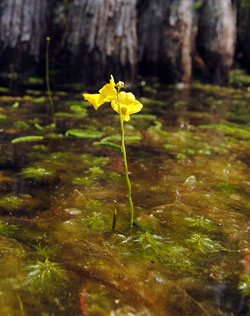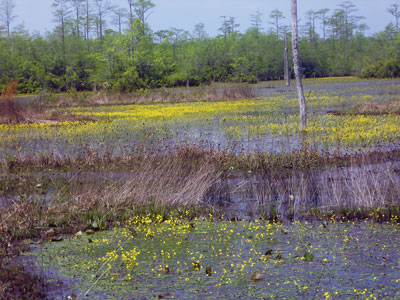The French explore Horseshoe Lake
By Ken Moore
Flora Columnist
You may remember the Flora story last year of Muskie and Vikki Cates leading a group of paddlers down to explore the pond cypress, Taxodium ascendens, swamp of Horseshoe Lake in Suggs Mill Pond Game Lands. Seeing thousands of carnivorous trumpet pitcher plants, Sarracenia flava, in flower, as I described, was a “died-and-gone-to-heaven†botanical adventure definitely worth a paddle!
Well now, Muskie did it again and this time was joined by N.C. Botanical Garden assistant director for conservation Johnny Randall, accompanied by French student interns Lise Marchal and Arnaud Fâche, eager to experience, first-hand, some of the diversity of “wild North Carolina.â€
The day was memorable. As soon as he stepped from Johnny’s canoe-laden truck, Arnaud peered across cypress-rimmed Horseshoe Lake and exclaimed, “Wow, cypress trees growing in their natural habitat!†And that was just the beginning of a day paddle filled with countless botanical discoveries.
Lise and Arnaud are second-year students in a five-year landscape architecture program at the National School of Higher Studies in Blois, France. Their program requires an internship of practical botanical-garden training. Mutual good fortune brought them to Chapel Hill-Carrboro, where they are learning while assisting with the Botanical Garden’s new landscape installation, invasive-plant control and seed-cleaning, as well as working in the Coker Arboretum, Battle Park, Mason Farm Biological Reserve and local community gardens.

Lise Marchal and Arnaud Fâche, French landscape-architecture students, are studying “wild North Carolina†as spring interns at the N.C. Botanical Garden. Photo by Johnny Randall
While here, visiting “wild North Carolina†from the mountains to the sea is becoming an important part of their experience.
Lise says that the emphasis in the program at Blois “is not about memorizing a couple hundred landscape plants, but on learning to make close observations and developing skills in understanding the ‘nature’ of distinctive natural landscapes and making application to human-made landscapes.â€
Among Lise’s memorable images of Horseshoe Lake are the ancient-looking bonsai-type cypress trees scattered here and there beneath the high canopy of the cypress forest.
Muskie’s trip this time was a little later than last year and pitcher plants were past flowering prime. This time the spectacle of the day was acres of bladderworts, Utricularia spp., giving a yellow “buttercup-meadow†appearance over the pond surface. Arnaud’s keenness for botanical details had us all taking a “closer look†at the bladderwort flowers and, particularly, those tiny, insect-trapping bladder devices along the capillary, thread-like aquatic leaves that support the plants’ flowering stems.
To these exploring French students, Suggs Mill Pond was every bit as engaging as Monet’s famous garden’s water-lily pond.
In a few weeks, Lise and Arnaud will take leave to visit other regions of our country, carrying with them rich memories of “wild North Carolina.â€
Email Ken Moore at flora@carrborocitizen.com.
Find previous Ken Moore Citizen columns at The Annotated Flora.

Tiny black dots on the canoe paddle are the insect-trapping “bladders†on bladderwort’s capillary leaves. Photo by Arnaud Fâche





Comments are closed.